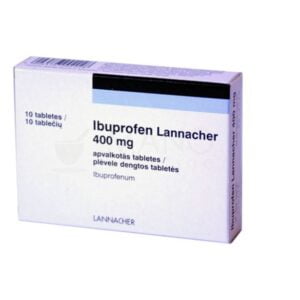Active Substance of No-Spa:
Drotaverine is the active substance in No-Spa, which acts as an antispasmodic medication. It inhibits phosphodiesterase 4 (PDE4) enzyme, leading to increased cyclic adenosine monophosphate (cAMP) concentration and relaxation of smooth muscles.
Pharmacological Effect of No-Spa:
Drotaverine, an isoquinoline derivative, selectively inhibits PDE4 without affecting PDE5 and PDE3 isozymes. As a result, it effectively increases cAMP concentration, leading to the inactivation of myosin light chain kinase (MLCK) and subsequent smooth muscle relaxation. Consequently, it proves to be highly effective in the treatment of hyperkinetic disorders and gastrointestinal spasms.
In particular, PDE3 is the primary isoenzyme responsible for the hydrolysis of cAMP in smooth muscle cells and vascular tissues. Notably, No-Spa exhibits its spasmolytic effect without inducing adverse effects on the cardiovascular system. This allows it to effectively address spasms in various areas, including the gastrointestinal tract, biliary tract, urinary system, and circulatory system. Furthermore, its vasodilator action enhances tissue blood flow, contributing to its overall therapeutic efficacy.
Pharmacokinetics:
No-Spa is rapidly and completely absorbed when taken orally or administered parenterally. The maximum concentration (Cmax) is reached within 45-60 minutes. It binds to plasma proteins, including albumin, alpha, alpha and beta globulins.
No-Spa undergoes metabolism in the liver and has a half-life (T1/2) of 16-22 hours after 72 hours. It is mainly excreted as metabolites, with 50% excreted in the urine and 30% in the feces.
Indications:
No-Spa is used to treat smooth muscle spasms associated with various conditions, including:
- Biliary tract diseases: cholelithiasis, cholecystitis, pericholecystitis, cholangitis, and papillitis.
- Urinary system spasms: urolithiasis, pyelitis, cystitis, and tenesmus of the bladder.
- Shortening the phase of cervical dilation during physiological delivery (intravenous and intramuscular administration).
- Adjuvant therapy for spasms in the digestive tract smooth muscles: stomach ulcer, duodenal ulcer, gastritis, spasms of cardia and pylorus, enteritis, colitis, constipation, and flatulence.
- Tension headaches (Oral).
- Gynecological diseases (dysmenorrhea).
- Strong labor pains (intravenous and intramuscular administration).
When tablets cannot be used, the parenteral formulation is administered.
No-Spa Dosage and Administration:
The recommended daily dose of No-Spa for adults is 120-240 mg, taken 2-3 times per day. In the case of children, the dosage is adjusted based on their age. For children aged 1 to 6 years, the recommended dose is 40-120 mg, taken 2-3 times per day. Similarly, for children over 6 years, the dose is 80-200 mg, taken in 2-5 separate administrations.
Moreover, the average daily intramuscular dose for adults ranges from 40-240 mg, which is divided into 1-3 injections per day.
Additionally, in the case of acute colic involving the kidney or bile, the drug is administered intravenously at a dose of 40-80 mg.
To shorten the cervical dilation phase during labor, a single intramuscular dose of 40 mg is administered. If the desired effect is not achieved, the dose may be repeated once every 2 hours.
No-Spa Side Effects:
No-Spa may rarely cause nausea, constipation, headache, dizziness, insomnia, palpitations, and very rarely, hypotension. In some cases, allergic reactions, particularly in patients with hypersensitivity to sodium metabisulfite, may occur (for parenteral administration).
Contraindications:
No-Spa should not be used in individuals with severe renal or hepatic impairment, severe heart failure, children under 1 year old (for tablets), or hypersensitivity to Drotaverine or any excipient of the drug (especially sodium metabisulfite for intravenous and intramuscular solutions).
Caution should be exercised when using No-Spa in patients with hypotension. During intravenous administration, the patient should be in a prone position to prevent the risk of collapse.
Pregnancy and Lactation:
Drotaverine is not teratogenic or embryotoxic, but its use during pregnancy is recommended only after carefully weighing the expected benefits against possible risks. Due to the lack of clinical data, Drotaverine is not recommended during lactation (breastfeeding).
Special Instructions:
No-Spa tablets contain 52 mg of lactose, so patients with lactase deficiency, galactosemia syndrome, or impaired glucose/galactose absorption should not take the drug in tablet form.
The solution for intravenous and intramuscular administration contains sodium bisulfite, which may cause allergic reactions, including anaphylaxis and bronchospasm in susceptible individuals (especially those with bronchial asthma or a history of allergic reactions). If hypersensitivity to sodium metabisulfite is present, parenteral administration of the drug should be avoided.
Effects on Ability to Drive and Operate Machinery:
At therapeutic doses, Drotaverine does not affect the ability to perform potentially hazardous activities.
Following parenteral administration, especially intravenous injection, it is recommended to refrain from driving motor vehicles and operating machinery for 1 hour.
No-Spa Overdose:
No cases of drug overdose with No-Spa have been reported.
Drug Interactions:
Concurrent use of No-Spa can reduce the antiparkinsonian effect of levodopa.
Storage Conditions:
No-Spa tablets should be stored in blister packs at a temperature not exceeding 30°C. The tablets should be kept in a polypropylene vial, and the solution for intravenous and intramuscular administration should be stored in a dark place at a temperature of 15°C to 25°C. The shelf life is 5 years.




Reviews
There are no reviews yet.